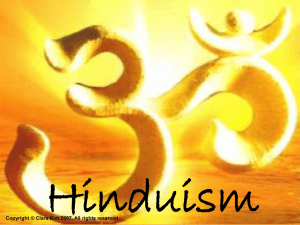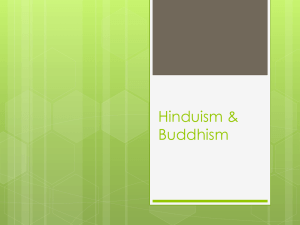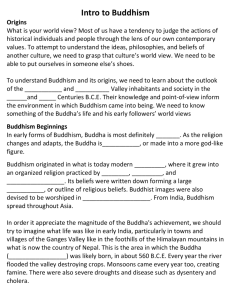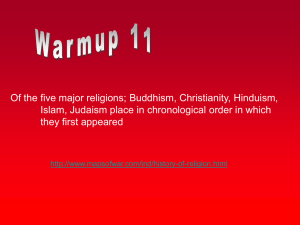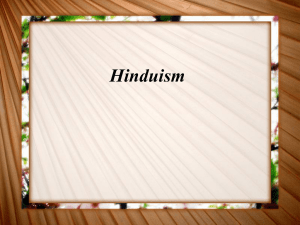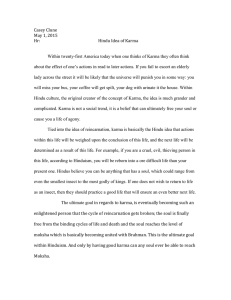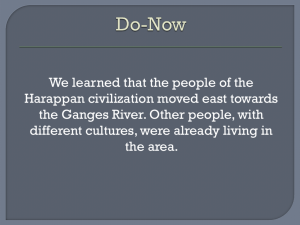Believe in other Gods who are aspects of Supreme God Brahman
advertisement
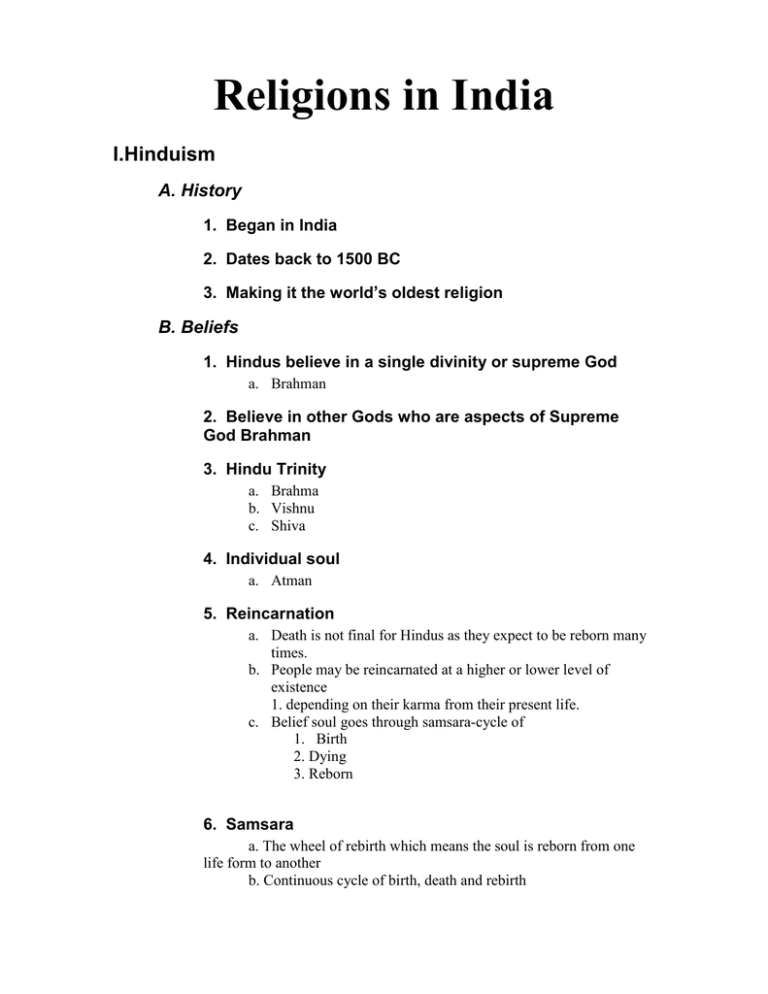
Religions in India I.Hinduism A. History 1. Began in India 2. Dates back to 1500 BC 3. Making it the world’s oldest religion B. Beliefs 1. Hindus believe in a single divinity or supreme God a. Brahman 2. Believe in other Gods who are aspects of Supreme God Brahman 3. Hindu Trinity a. Brahma b. Vishnu c. Shiva 4. Individual soul a. Atman 5. Reincarnation a. Death is not final for Hindus as they expect to be reborn many times. b. People may be reincarnated at a higher or lower level of existence 1. depending on their karma from their present life. c. Belief soul goes through samsara-cycle of 1. Birth 2. Dying 3. Reborn 6. Samsara a. The wheel of rebirth which means the soul is reborn from one life form to another b. Continuous cycle of birth, death and rebirth 7. Karma a. Force that determines the quality of life b. Depending on how well one has behaved in past live c. Create karma by actions on earth d. If you live a good life, you create good karma. If you live a bad life, you create bad karma 8. Moksha a. Hindu soul is born into a better life, b. Has the opportunity to improve itself further, and get closer to ultimate liberation. c. One attains Moksha when one has "overcome ignorance", and no longer desires anything at all d. The ones who reach this state no longer struggle with the cycle of life and death. e. The way to get to Moksha is to not create any karma. f. Three paths to achieve Moksha 1. The path of duty, 2. The path of knowledge 3. The path of devotion (unconditional surrender to God) C. Hindu Trinity 1. Brahma a. First member of Hindu Trinity b. The Creator c. Periodically creates everything in our universe d. Hindu belief that time is cyclical e. everything in universe is, except for BRAHMAN and certain scriptures, created, maintained an for a certain time then destroyed 2. Vishnu a. Second member of Hindu Trinity b. The Preserver c. Maintains order and harmony of the universe d. Worshipped in many forms e. Important and mysterious God f. Pervader-divine essence 3. Shiva a. Third member of Hindu Trinity b. The Destroyer c. Tasked to destroy the universe to prepare for its renewal d. Destructive power is regenerative D. Dharma 1. Ethical duty based on the divine order of reality. 2. Belief a person has an obligation or a duty E. Varna a. Social class a person is born into and cannot change 1. Brahmans or Brahmins – The intellectuals and the priestly class who perform religious rituals 2. Kshatriya (nobles or warriors) – Who traditionally had power. 3. Vaishya (commoners or merchants) – Ordinary people who produce, farm, trade and earn a living 4. Shudras (workers) – Who traditionally served the higher classes, including laborers, artists, musicians, and clerks F. Sacred Text or Writings 1. Vedas a. A collections of Sanskrit hymns (written down 1200900BCE, but based on older oral versions) b. Oral traditions that had been handed down were recorded in sacred books called Vedas, or “Books of Knowledge.” 2. Upanishads a. Means the inner or mystic teaching that were passed down from guru (teacher) to disciple (student). G. Diwali 1. 2. 3. 4. 5. Festival of lights Series of five festivals Lights are floated on small rafts If the candle remains lit, good luck will follow India's biggest and most important holiday of the year H. Ganges River 1. The water of the Ganges is sacred enough to purify all sins I. Banaras 1. Hindus Holy City 2. People travel from all over to bathe in the Ganges 3. It has 1500 temples, most of them devoted to Shiva 4. A gathering place for the religiously learned and their disciples. II.Jainism A. An ancient religion from India that B. Teaches that the way to liberation and bliss is to live a life of harmlessness and renunciation. C. The aim of Jain life is to achieve liberation of the soul. III.Buddhism A. The philosophy of Buddhism is based on the teachings of Lord Buddha 1. Siddhartha Gautama (563 and 483 BC), a royal prince of Kapilvastu, India. 2. At the age of twenty nine he left the comforts of his home to seek answer to the cause of human sufferings. 3. Gautama became the enlightened one, the Buddha, after wandering and meditation for six years. B. Buddhism teaches its followers to perform good and wholesome actions and to purify and train the mind. C. Final goal is to achieve Nirvana D. Spread of Buddhism 1. The Buddha spent 45 years traveling throughout India teaching the Four Noble Truths and the Eightfold Path. 2. Through his efforts, he was able to gain a large following of several thousand disciples. 3. After his death, the Buddha’s followers continued to travel, preaching the new religion throughout the Asian continent, into China, Japan, Korea, and eventually throughout the World. E. Four Nobel Truths 1. Life is suffering; 2. Suffering is due to attachment 3. Attachment can be overcome 4. There is a path for accomplishing this F. Eight Fold Path 1. Right view is the true understanding of the four noble truths. 2. Right aspiration is the true desire to free oneself from attachment, ignorance, and hatefulness. 3. Right speech involves abstaining from lying, gossiping, or hurtful talk. 4. Right action involves abstaining from hurtful behaviors, such as killing, stealing 5. Right livelihood means making your living in such a way as to avoid dishonesty and hurting others, including animals. 6. Right effort is a matter of exerting oneself in regards to the content of one's mind: Bad qualities should be abandoned and prevented from arising again; Good qualities should be enacted and nurtured. 7. Right mindfulness is the focusing of one's attention on one's body, feelings, thoughts, and consciousness in such a way as to overcome craving, hatred, and ignorance. 8. Right concentration is meditating in such a way as to progressively realize a true understanding of imperfection, impermanence, and non-separateness.
